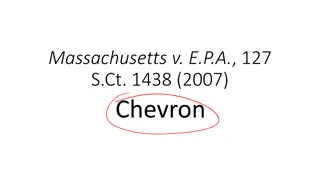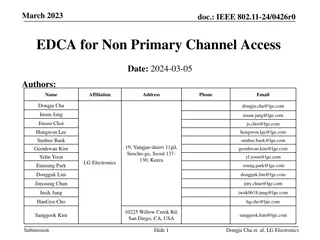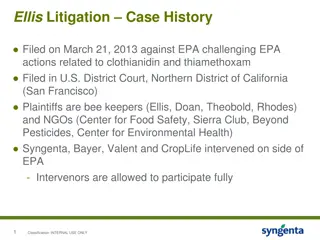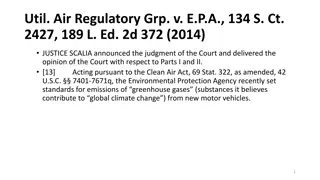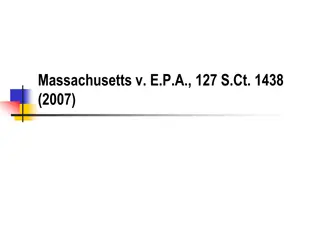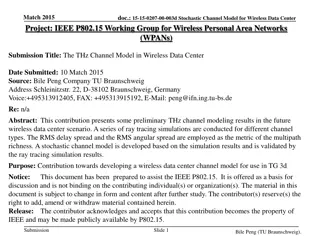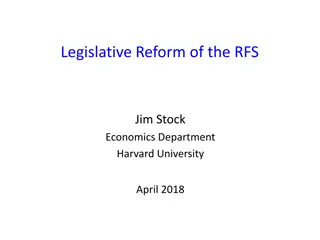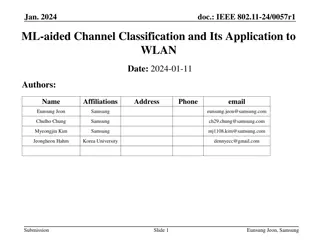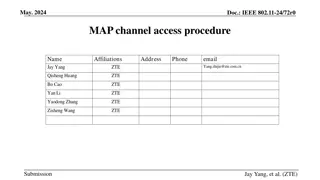The Impact of EPA on Ethanol Effect of BK Channel
Alcohol Use Disorders (AUDs) are a significant issue in society, with gene and environmental factors contributing to alcoholism. Ethanol, when consumed excessively, can severely impact physical and behavioral health by altering neurotransmitter levels. The presence of Eicosapentaenoic Acid (EPA), an omega-3 fatty acid, may influence the ethanol effect on Big Potassium (BK) channels, which play a crucial role in neuronal activity and are affected by ethanol exposure. Further research is needed to understand how EPA interacts with ethanol and BK channel function.
Download Presentation

Please find below an Image/Link to download the presentation.
The content on the website is provided AS IS for your information and personal use only. It may not be sold, licensed, or shared on other websites without obtaining consent from the author. Download presentation by click this link. If you encounter any issues during the download, it is possible that the publisher has removed the file from their server.
E N D
Presentation Transcript
Whether the Ethanol effect of BK channel is affected by the presence of EPA BY: AMRITA KONDETI 12/3/19
Background Alcohol Use Disorders (AUDs) are a profound and common problem affecting millions of Americans in the U.S. Gene factors and environmental factors both play a role in the development of alcoholism The problem is that the cause of alcoholism is not well understood Ethanol taken in excess amounts is the most toxic substances of behavioral and physical health Ethanol can also affect the brain chemistry by altering levels of neurotransmitters Chronic use of ethanol can lead to alcoholism or alcohol abuse and numerous medical conditions
Level of Response (LR) A combination of counteracting response to alcohol, including the level of sensitivity to the drug and the degree to which tolerance develops during the drug exposure. This form of tolerance is known as Acute Functional Tolerance (AFT) Human studies (Schuckit et al.) have shown that there is an inverse correlation between an individual s LR and their likelihood to develop AUDs later in life. This means that somebody who has a high LR will less likely become an alcoholic compared to somebody who doesn t feel the effects of alcohol strongly. AFT is one of the factors that dictates LR. If someone as a high AFT, then they are less likely to feel the effects of alcohol because the tolerance is quick. Lower LR will lead to greater chance of developing alcoholism. Higher AFT = Lower LR lips-7 gene was the first indication that lipids in C. elegans were important to AFT Mutations affecting multiple genes that regulate levels of Triacylglycerol (TAGs) altered the level of AFT. Indicates that there s a significant role for lipids in the development of AFT
Eicosapentaenoic Acid (EPA) An omega-3 polyunsaturated fatty acid found in fish oils. Best known for the brain development and nervous system function which is used for neural activity
Arachidonic Acid (APA) Integral constituent of a cell membrane, conferring it with fluidity and flexibility, so it is necessary for the function of all cells, especially in nervous, skeletal and immune systems. Modulates the function of ion channels, several receptors and enzymes for activation and inactivation
Big Potassium Channels (BK Channels) Voltage-gated potassium channels that conduct large amounts of potassium ions (K+) across the cell membrane. They will be activated by either electrical means or by increasing calcium concentrations in the cell Their function is to repolarize the membrane potential by allowing for potassium to flow outward. Plays a dominant role in neuronal activity and is affected by ethanol. Several minutes of ethanol exposure can lead to an increased BK current.
Hypothesis One of the factors that seem to be important for AFT are lipids, particularly EPA is shown to be required for the development of AFT, so this may effect the BK channel in the membrane. Why is EPA required? What is it doing that is important for AFT? Hypothesize: Does the presence of EPA as a component of a lipid bilayer can alter how the ethanol is activating the BK channel?
Experiment Major components (Avanti Polar Lipids, Alabaster, Alabama) Artificial membrane containing 1,2-dioleoyl-sn-glycero-3-phosphoethanolamine (DOPE) /1-palmitoyl-2- oleoyl-glycero-3-phosphocholine (POPC) - CONTROL Artificial membrane containing 1,2-dioleoyl-sn-glycero-3-phosphoethanolamine (DOPE) /1-O-hexadecyl- 2-(5Z,8Z,11Z,14Z,17Z-eicosapentaenoyl)-sn-glycero-3-phosphocholine, - Testing EPA Artificial membrane containing 1,2-dioleoyl-sn-glycero-3-phosphoethanolamine (DOPE) /1-palmitoyl-2- arachidonoyl-sn-glycero-3-phosphocholine. Testing AA Getting and incorporating BK channels into all 3 artificial membranes Adding ethanol
Step 1: Making artificial membrane (Siontorouet al, 2017) Dipping method Dip metal wire into lipid solution (3:1) Transfer metal wire into electrolyte solution. Lipid drop will self organize into bilayer at the tip of the wire Tethering Thiolipids or hydrogels for anchoring layer
Step 2: Human Embryonic Kidney (HEK) 293 MembranePreparation (Crowley et al, 2003) Hslo cDNA gene will be expressed to create the BK channel. HEK 293 membrane fragments will be isolated HEK 293 cells will be transfected with hslo cDNA and grown to converge and form pellets, and then the cells will resuspend on ice in 10mL of buffer: 30mM KCI, 2mM MgCl2, 10mM HEPES (buffering agent), and 5 mM EGTA (chelate agent, pH 7.2) The cell suspension will be forced through a 27-gauge needle 4 times and then ultrasonic vibration will be used at 30% maximum power for 30 seconds, twice The suspension will be layered on a 20 to 38% sucrose density gradient and centrifuged at 25,000 rpm for 60 minutes at 4 degrees Celsius Then a syringe will be used to collect the band at the 20 to 38% interface, and it will be diluted with bi-distilled H20, and centrifuged in a 50.2 Ti rotor at 45, 000 rpm for 50 minutes at 4 degrees Celsius The resulting pellet will be resuspended in 200 ul of buffer: 250 mM sucrose and 10 mM HEPES, Ph 7.3 All the aliquots will be stored at -80 degrees Celsius until used.
Step 3: Inserting hslo BK channels into artificial membranes (Crowley et al, 2005) The Bk channels will be incorporated by dropping 0.5 to 1 ul of the membrane preparation and pipetting into the artificial bilayer Next step is to check for BK channel functioning in artificial membrane.
Measuring Results - Patch Clamp Method for Electrophysiology (Leviset al, 1992) Electrophysiology of the Bk channel to measure BK channel s electrical activity. A patch clamp method is used. A hollow glass tube such as a micropipette or patch pipette with a very small opening will be used to make tight contact with a tiny area of the artificial membrane After the application of a small amount of suction to the back of the pipette, the seal between pipette and membrane will become so tight that no ions will flow between the pipette and the artificial membrane thus all the ions that flow when the BK channel opens must flow into the pipette The resulting electrical current will be measured with an ultra-sensitive electronic amplifier connected to the pipette. This arrangement will be the membrane-attached patched clamp recording method A record of the current flowing through the BK channel will reveal when the channel is in an open or closed state.
Step 4: Adding ethanol Add 50 mM ethanol and perform electrophysiology again
Expected Results (Crowley et al, 2005) No Ethanol Checking to see whether the control, EPA or AA has affected the BK channel with the most electrical current. Before Ethanol is added there should be activation in all three test lipid environments Ethanol After Ethanol is added, the BK channels in the EPA-containing membrane should have the least electrical current compared to control and AA-containing membranes. Expectations of EPA
Discussion If my hypothesis is supported, overall the BK channel should have less electrical activity in the artificial membrane containing EPA when in the presence of ethanol This would suggest that the presence of EPA can reduce the sensitivity of the BK channel to ethanol, which could explain the requirement for EPA in the development of acute functional tolerance Pitfall there might be no activity produced by the BK channel in the EPA-or AA-containing membranes Limitation using artificial membrane









